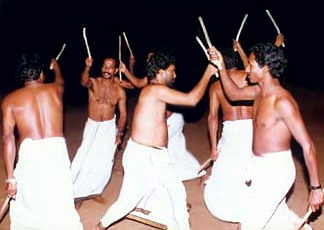The Moplahs speak Malayalam and all Moplah children are taught to memorize the Quran. Islamic religious and social tenets were also taught in the same manner. This gave rise to a class of priests who specialized in Islamic theology and were called `Musaliyars.` The Moplahs are Sunni Muslims and mainly follow the Shafei school of thought. However a Shia shrine at Kondotti (near Calicut) is also to be found. It is looked after by a family of Thangals who migrated from Iran.
The Moplahs did not take kindly to modern education. They developed a form of writing known as Arabi Malayalam in which Malayalam is written in the Arabic script. They also composed songs and ballads which are essentially based on Malayalam but they have borrowed freely from Arabic, Persian, Urdu and Tamil. This literature is known as Mapilla Patu.
 Because of religious inhibitions, the only dance form developed by the Moplahs is the vigorous Kolkali. Twelve muscular men, with sticks and tiny cymbals attached to them, dance in a circle with the leader in the middle who sings, the players joining in the refrain. Some very intricate steps and a great deal of acrobatics are involved and the training generally takes place in Kalaris (local gymnasia). The women also have a sort of dance called Kaikotti Kali, which is accompanied with songs and hand clapping and is generally performed at the time of weddings.
Because of religious inhibitions, the only dance form developed by the Moplahs is the vigorous Kolkali. Twelve muscular men, with sticks and tiny cymbals attached to them, dance in a circle with the leader in the middle who sings, the players joining in the refrain. Some very intricate steps and a great deal of acrobatics are involved and the training generally takes place in Kalaris (local gymnasia). The women also have a sort of dance called Kaikotti Kali, which is accompanied with songs and hand clapping and is generally performed at the time of weddings.
The average Moplah is independent, self-respecting and upright. Some of the finest delineation of Moplah character is to be found in the novels Vroob by K.C. Kuttikrishnan and Asura Vittu by M.T.V. The study of the Moplahs has been done with originality and lyrical beauty by Vaikom Muhammed Basheer in the milieu of his own village in central Travancore. Dalya Kala Sakhi`s Childhood Friend and Kunhipathumaayude Adu`s Kunhipathumma`s Goat are other Moplah stories. N.P. Mohammed, too, has written some fine stories centering around Moplah life and character.
The Moplahs are hardworking and adventurous. The peasantry fishermen and traders are industrious and thrifty. A large number of them plied lucrative trades in Burma, Singapore, Malaysia, Indonesia, in the Gulf Sheikhdoms and the Arabian mainland.
Many have married and settled down in these countries though they keep up their contacts with India. They are some of the best lumberjacks in the country and are also very good at bridge and pier construction in underwater conditions. There are influential trading people in the higher strata, especially in Calicut and Cannanore, particularly in the timber and timber-based industries. Some are large land owners and planters as well.




















